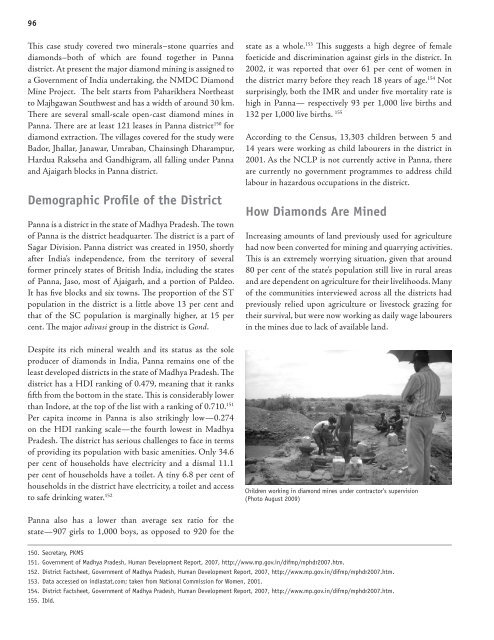Children - Terre des Hommes
Children - Terre des Hommes
Children - Terre des Hommes
Create successful ePaper yourself
Turn your PDF publications into a flip-book with our unique Google optimized e-Paper software.
96<br />
This case study covered two minerals–stone quarries and<br />
diamonds–both of which are found together in Panna<br />
district. At present the major diamond mining is assigned to<br />
a Government of India undertaking, the NMDC Diamond<br />
Mine Project. The belt starts from Paharikhera Northeast<br />
to Majhgawan Southwest and has a width of around 30 km.<br />
There are several small-scale open-cast diamond mines in<br />
Panna. There are at least 121 leases in Panna district 150 for<br />
diamond extraction. The villages covered for the study were<br />
Bador, Jhallar, Janawar, Umraban, Chainsingh Dharampur,<br />
Hardua Rakseha and Gandhigram, all falling under Panna<br />
and Ajaigarh blocks in Panna district.<br />
Demographic Profile of the District<br />
Panna is a district in the state of Madhya Pra<strong>des</strong>h. The town<br />
of Panna is the district headquarter. The district is a part of<br />
Sagar Division. Panna district was created in 1950, shortly<br />
after India’s independence, from the territory of several<br />
former princely states of British India, including the states<br />
of Panna, Jaso, most of Ajaigarh, and a portion of Paldeo.<br />
It has five blocks and six towns. The proportion of the ST<br />
population in the district is a little above 13 per cent and<br />
that of the SC population is marginally higher, at 15 per<br />
cent. The major adivasi group in the district is Gond.<br />
Despite its rich mineral wealth and its status as the sole<br />
producer of diamonds in India, Panna remains one of the<br />
least developed districts in the state of Madhya Pra<strong>des</strong>h. The<br />
district has a HDI ranking of 0.479, meaning that it ranks<br />
fifth from the bottom in the state. This is considerably lower<br />
than Indore, at the top of the list with a ranking of 0.710. 151<br />
Per capita income in Panna is also strikingly low—0.274<br />
on the HDI ranking scale—the fourth lowest in Madhya<br />
Pra<strong>des</strong>h. The district has serious challenges to face in terms<br />
of providing its population with basic amenities. Only 34.6<br />
per cent of households have electricity and a dismal 11.1<br />
per cent of households have a toilet. A tiny 6.8 per cent of<br />
households in the district have electricity, a toilet and access<br />
to safe drinking water. 152<br />
state as a whole. 153 This suggests a high degree of female<br />
foeticide and discrimination against girls in the district. In<br />
2002, it was reported that over 61 per cent of women in<br />
the district marry before they reach 18 years of age. 154 Not<br />
surprisingly, both the IMR and under five mortality rate is<br />
high in Panna— respectively 93 per 1,000 live births and<br />
132 per 1,000 live births. 155<br />
According to the Census, 13,303 children between 5 and<br />
14 years were working as child labourers in the district in<br />
2001. As the NCLP is not currently active in Panna, there<br />
are currently no government programmes to address child<br />
labour in hazardous occupations in the district.<br />
How Diamonds Are Mined<br />
Increasing amounts of land previously used for agriculture<br />
had now been converted for mining and quarrying activities.<br />
This is an extremely worrying situation, given that around<br />
80 per cent of the state’s population still live in rural areas<br />
and are dependent on agriculture for their livelihoods. Many<br />
of the communities interviewed across all the districts had<br />
previously relied upon agriculture or livestock grazing for<br />
their survival, but were now working as daily wage labourers<br />
in the mines due to lack of available land.<br />
<strong>Children</strong> working in diamond mines under contractor’s supervision<br />
(Photo August 2009)<br />
Panna also has a lower than average sex ratio for the<br />
state—907 girls to 1,000 boys, as opposed to 920 for the<br />
150. Secretary, PKMS<br />
151. Government of Madhya Pra<strong>des</strong>h, Human Development Report, 2007, http://www.mp.gov.in/difmp/mphdr2007.htm.<br />
152. District Factsheet, Government of Madhya Pra<strong>des</strong>h, Human Development Report, 2007, http://www.mp.gov.in/difmp/mphdr2007.htm.<br />
153. Data accessed on indiastat.com; taken from National Commission for Women, 2001.<br />
154. District Factsheet, Government of Madhya Pra<strong>des</strong>h, Human Development Report, 2007, http://www.mp.gov.in/difmp/mphdr2007.htm.<br />
155. Ibid.






